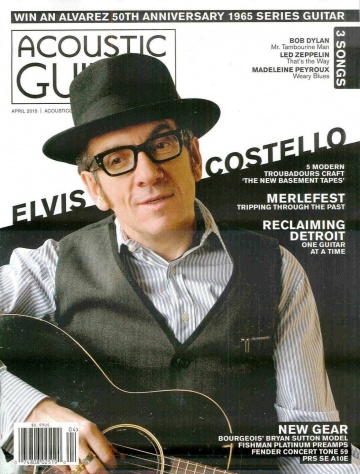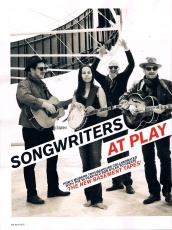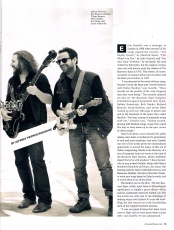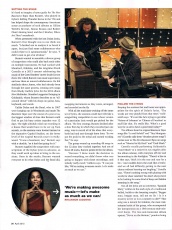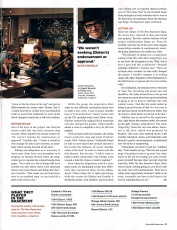Acoustic Guitar, April 2015: Difference between revisions
(+detail +image links) |
(+text part 1) |
||
| Line 10: | Line 10: | ||
'''How 5 modern troubadours collaborated with the 26-year-old Bob Dylan to create ''The New Basement Tapes'' | '''How 5 modern troubadours collaborated with the 26-year-old Bob Dylan to create ''The New Basement Tapes'' | ||
{{Bibliography text}} | {{Bibliography text}} | ||
Elvis Costello was a teenager in London in 1968 when several UK hit songs piqued his interest: "The Mighty Quinn," by Manfred Mann; "This Wheel's on Fire," by Julie Driscoll; and "You Ain't Goin' Nowhere," by the Byrds. All were written by Bob Dylan, but his original versions were not well-known until the release of ''The Basement Tapes'' in 1975. That album, of course, consisted of sessions Dylan had recorded with the Band years before, in 1967. | |||
"I was attracted to the mood of those songs, because I loved the Band and I loved [Dylan's] ''John Wesley Harding''," says Costello. "Those records are the product of the work shopping that they were doing." The recently released six-disc set ''The Basement Tapes Complete'' (Columbia/Legacy) documents how Dylan, Robbie Robertson, Rick Danko, Richard Manuel, Garth Hudson, and Levon Helm worked up well over 100 songs in Dylan's den and in the basement of the house they called Big Pink. "You hear a group of musicians trying stuff out," Costello says, "fooling around, playing half-finished songs, songs that sound like they've been made up on the spot, covers by other people." | |||
Those lo-fi demos, never intended for public release, have been a touchstone for generations of rock and roots musicians. Last year, Costello was one of five artists given the extraordinary opportunity to extend the legacy of that era of Dylan's songwriting, thanks to the discovery of a box of forgotten lyrics he wrote at the time of the ''Basement Tapes'' sessions. Dylan's publisher shared the lyrics with producer T Bone Burnett, who in turn invited Costello, along with Marcus Mumford (Mumford and Sons), Jim James (My Morning Jacket), Taylor Goldsmith (Dawes), and Rhiannon Giddens (Carolina Chocolate Drops), to write new songs based on Dylan's words, and to record them as an ad-hoc band. | |||
The result is ''Lost on the River: The New Basement Tapes'', which, apart from its Dylanological significance, is simply a great album—frisky and fun, stylistically varied yet unified, too. The five artists not only rose to the challenge of making songs from Dylan's 47-year-old scribbling, but they stayed true to the freewheeling spirit of the original basement sessions. | |||
"It was our good fortune that these lyrics came to light and we were given them to play with," says Costello. "it was a playground." | |||
| Line 17: | Line 26: | ||
{{cx}} | {{cx}} | ||
{{rttc}} | |||
{{Bibliography notes header}} | {{Bibliography notes header}} | ||
Revision as of 12:31, 5 May 2015
|
